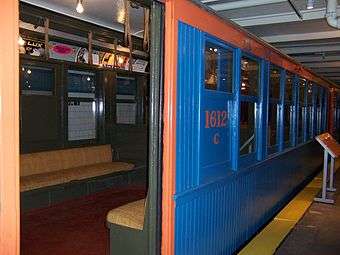Q-type Queens car (New York City Subway car)
The Q-type and QX were a New York City Subway car class originally built by the Osgood-Bradley, Brill, Laconia, and Jewett car companies, and rebuilt in 1938 by the Brooklyn–Manhattan Transit Corporation (BMT) from former BU cars. These cars were one of the two car types to be rebuilt by the BMT from BU cars, the other being the C-types.
| Q-Type Queens car | |
|---|---|
 BMT Q-Type car #1612C on display at the New York Transit Museum | |
 Interior view of Q-type car 1612C | |
| In service | 1938-1969 |
| Manufacturer | Osgood Bradley Car Company J. G. Brill Company Laconia Car Company Jewett Car Company Brooklyn–Manhattan Transit Corporation |
| Constructed | 1938 |
| Number built | 114 cars assembled into 42 operating units |
| Number preserved | 2 |
| Number scrapped | 112 |
| Formation | Three-car sets (Q) or two-car sets (QX) |
| Fleet numbers | 1600-1629 A-B-C (Q) 1630-1641 A-B (QX) |
| Capacity | 50 seats (A and C cars), 52 seats (B car)(Q)/ 50 seats (A and B cars)(QX) |
| Operator(s) | Brooklyn–Manhattan Transit Corporation |
| Specifications | |
| Car body construction | Wood with steel frames and ends |
| Train length | 137 feet (41.8 m) over the extreme ends of each unit |
| Car length | 49 feet 3 inches (15.01 m) |
| Width | 8 feet 8 inches (2.64 m) |
| Height | 12 feet (3.66 m) |
| Weight | 57,000 lb (26,000 kg) |
| Traction system | WH 225113 (Q) WH 225112 (QX) GE 259, WH 336 (Q, 1 per motor truck) WH 300 (QX, 2 per motor truck) |
| Power output | 120 hp (89 kW) per motor (Q) 200 hp (150 kW) per motor (QX) |
| Track gauge | 4 ft 8 1⁄2 in (1,435 mm) (standard gauge) |
Description
The Q-types were built for elevated railway service to the 1939 New York World's Fair. They were rebuilt from BU cars in the 1200 and 1400 series, elevated rolling stock originally built in 1903 and in 1907. There were 30 three-car Q sets numbered 1600-1629 A-B-C, and 12 two-car QX sets numbered 1630-1641 A-B. The Q sets were arranged in three-car sets, while the QX sets were arranged as married pairs.[1]
After BMT service on the joint IRT-BMT Flushing Line ended in 1949, the Q-types were refitted for operation of the IRT Third Avenue Line in Manhattan. After the latter line closed in 1955, the Q-types were refitted again to operate on the BMT Myrtle Avenue Line in 1958 to replace the last elevated gate cars in passenger service. When the lower part of the Myrtle Avenue Line closed in 1969, the Q-types were finally retired.[2][3] The oldest of the cars were in revenue service for 66 years, currently the longest such service life in New York City rapid transit operations.
Preservation
- Car 1602A (ex-BU 1410) is preserved the Trolley Museum of New York.[4] It is awaiting restoration.
- Car 1612C (ex-BU 1417) is preserved at the New York Transit Museum. This car was previously used as a work car before it was restored to its original condition for the museum collection in 1979. It is painted in its original blue and orange paint scheme (the colors of the New York City flag), which it wore during the 1939 World's Fair.
Q-type set 1622 A-B-C, was previously preserved by the New York Transit Museum. However, in 1979, the set was converted back into BU gate cars 1407, 1273 and 1404 (their original numbers prior to conversion), although the cars retained their 1957 lowered roofs and 1950 lightweight trucks and motors.[5][6] Car 1612C was subsequently restored to replace 1622 A-B-C.
References
![]()
- https://www.nycsubway.org/wiki/The_BMT_Fleet_(Elevated,_Subway,_Experimental)#Q_Types
- NYC Subway Experimental Cars
- https://www.nycsubway.org/wiki/Chapter_1,_The_Elevated_Lines#Section_B:_The_.22Q.22_Cars
- BRT Subway Q Car Number 1602A (Kingston, New York Trolley Museum)
- https://www.nycsubway.org/wiki/Chapter_1,_The_Elevated_Lines#Section_C:_The_Brooklyn_Elevateds
- https://web.archive.org/web/20120205052834/http://thethirdrail.net/0011/64wf7.html